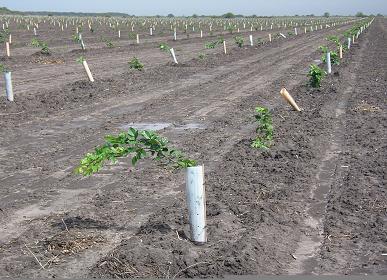TerViva Bioenergy works to bring pongamia oil to feedstock market



Photo: TerViva Bioenergy
February 3, 2012
BY Bryan Sims
As research continues to mount in an effort to find low-cost breeding, cultivation and harvesting methods of nonfood-based oil bearing crops such as jatropha, castor, moringa and algae for biodiesel production, Calif.-based TerViva Bioenergy Inc. is focused on the development and commercialization of a legume tree native to Australia and India—Pongamia pinnata—which, according to President and CEO Naveen Sikka, holds equal if not superior potential as a viable biodiesel feedstock in the U.S.
It wasn’t until he attended University of California-Berkeley in late 2008 through 2009 working toward a master’s degree in energy and finance that, together with his friends who would eventually co-create TerViva Bioenergy, Sikka was interested in pongamia and the promise it holds as an ideally suited feedstock for biodiesel.
“I think what we liked about it, after having visited some acreage in India and Australia, was that we felt it could be a truly economical and scalable crop in the U.S.,” Sikka told Biodiesel Magazine. “You hear a lot about jatropha and others, but they’re not really being cultivated here in the U.S. Because it’s a tree crop, it can be cultivated like a tree crop.”
According to Sikka, TerViva has developed special varieties of pongamia trees that produce pods that contain seeds. They typically contain between 30 to 40 percent oil, which consist of nearly 50 percent of oleic acid. The pods can be harvested via existing mechanical shaking equipment such as those employed in the nut industries and the oil can be extracted using existing crushing equipment with no modifications. After the oil is extracted, degummed and refined, it can then be shipped to biodiesel producers.
Advertisement
“It’s like a pistachio tree for the biodiesel industry,” Sikka said. “At the end of the day, that oil, those seeds, they go right into existing equipment. We’re going to work with the existing [biodiesel] industry, which we think have done things right.”
Pongamia trees, according to Sikka, are noninvasive and highly resistant to heat (more than 110 degrees Fahrenheit), drought and saline soils. It’s also tolerant to cold temperatures—which is a problem for jatropha—and it’s a nitrogen fixer, meaning the tree doesn’t require nitrogen fertilizers. In fact, the trees effectively replenish nitrogen in the soil, thereby rehabilitating distressed, marginal land. Pongamia requires between four and five years of growth before the tree is mature enough to be commercially harvested. It is, however, a fast-growing tree and life can extend far beyond 50 years.
TerViva has established test plot operations for cultivating and harvesting its elite lines of pongamia trees, 30,000 trees worth (about 200 acres), in south Texas in an effort that Sikka hopes will demonstrate and communicate to area farmers the benefits of pongamia as a valuable oilseed crop that can positively contribute to their overall operations. Sikka added the company intends to add trial acreage already established in Hawaii, as well as establish test plots on distressed citrus land in Florida.
“The biggest thing we learned about biofuels is that when you go to a farmer and you propose a biofuel crop, they don’t evaluate that biofuel crop in comparison to other biofuel crops,” Sikka said. “They evaluate it in comparison to anything they can do with their land. It’s not like a row crop like camelina, but if you’re patient, it works and it’s got a great benefit.”
Genetics in the wild from which TerViva is cultivating, according to Sikka, can produce as much as 2,000 gallons of oil per acre from the pongamia tree under ideal conditions.
Advertisement
“We don’t quote that much because we think when you plant it at a sufficiently dense scale and you put it into some tough conditions, you’re probably looking at more like 400 to 500 gallons of oil per acre,” Sikka said. “It’s a very good number compared to camelina or soy, but it’s also a different kind of organism.”
Sikka continued, “There’s millions of acres on which pongamia could be farmed in the U.S. If we run the fantasy tape and we say, ‘Ok, 10 barrels or 500 gallons of oil per acre multiplied by 100,000 put in over a decade, that equates to a lot of pongamia seed oil potential that could contribute as feedstock for the biodiesel industry.’”
Understanding the roots from which the biodiesel industry was built over the years, to where it is today, Sikka said he and his company look to introduce pongamia into the industry with ease and optimism.
“We had a lot of respect coming into this thing for the existing biodiesel community,” Sikka said.
Upcoming Events





